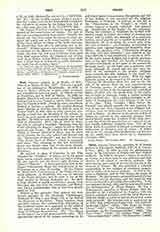

Veit, PHILIPP, painter, b. at Berlin, February 13, 1793; d. at Mainz, December 18, 1877. Veit was a grandson of the philosopher Mendelssohn. In 1815 he went to Rome, where he studied under Overbeck and Cornelius as their best pupil. In 1830 he settled at Frankfort, and in 1854 at Mainz. In 1808 his mother Dorothea and her second husband Friedrich Schlegel had become Catholics, and he followed them into the Church in 1810. About the same time also he decided to become a painter. He studied drawing under Matthai at Dresden, but by 1811 he went to Vienna where he first tried to paint portraits, producing several, but the blending of the colors, to which he gave special attention, caused him much trouble. In 1813 he took an honorable part in the War of Liberation. After this he went to Italy, but first he painted a beautiful “Madonna with the Child and John the Baptist”, which he left at Heiligenstadt near Vienna. He joined in the work of the colony of German painters at Rome, and his share of the frescoes for the villa called Casa Zuccari was the “Temptation of Joseph“, and also the fresco of “The Seven Years of Plenty”, which is unusually well done. The coloring in this last mentioned fresco was fresher than that of his artist friends; this is even more evident in the cartoon which is at Frankfort.
He painted in place of Cornelius in the Villa Massimi the “Paradise” of Dante, not in the grand style, but in a poetic manner that was full of feeling. He also painted here the lowest eight divisions of Dante’s “Heaven“. A fresco painted by him in the Museo Chiaramonti treats the rededication of the Colosseum as a place of worship. In Sta Trinity de’ Monti there is a Crowning of the Virgin which is much admired. At Frankfort, Veit was the director of the Stadel Institute, and he made it one of the chief centers of German Romantic art. He drew a large number of pupils around him, among them Settegast who was later his son-in-law, and Rethel, who always acknowledged that he had been greatly aided by Veit.
Besides a few portraits, Veit painted the well-known pictures of the Emperors Charlemagne, Frederick II, Otto I, and Henry VII, in the Hall of the Emperors at Frankfort. Taken together, these portraits convey the ecclesiastical conception of the medieval empire as it appeared to the mind of this painter, who was so strongly imbued with the ideas of Christian Romanticism. The “Two Marys at the Grave” has much greater artistic value. This pen-and-ink sketch of the women sorrowing on the still closed grave is harmonious throughout, and full of fine feeling; it was intended for the religious foundation at Neuburg. A contrast to this last is the “Presentation in the Temple“, in which a certain majesty is happily expressed. Veit painted an “Assumption of the Virgin” for the cathedral. During his residence at Frankfort he worked with restless energy to perfect the technic of drawing and color, and to justify the demands of a moderate realism, and of popular art as typified by Schadow at Dusseldorf. If, in so doing, he turned aside from the style of Overbeck and Cornelius, nevertheless he gained a more vigorous manner for himself by these efforts. His greatest work, “Christianity bringing the Fine Arts into Germany“, was painted in the years 1833-36; it was transferred to canvas in 1877. In the center stands Religion full of gentle graciousness; to the right Boniface, the Apostle of Germany, preaches Christianity in her name to the attentively listening youth; an old bard and a priestess turn away, although the sacred oak has just been cut down at the command of the apostle. Religion turns towards this side, holding in her hand the palm-branch, the promise of peace. With the right hand she points to the Gospel as the source of truth. Christian life flourishes about her, and on the left side of the picture there are seen representations of Christian poetry, of medieval knighthood, of music, and farther in the background the symbolical figures of other arts, the monk dead to the world, but devoted to learning; finally a Gothic building and a civilized city. As a painting belonging to the realm of imagination the work belongs to the best of its class. When Lessing’s “Huss before the Council” was placed opposite his own painting by way of contrast, Veit, wounded in his religious convictions, went to Sachsenhausen and later accepted a call to Mainz. As director of the picture gallery of Mainz he painted in the cathedral pictures from sacred history under the windows of the main nave, a task for which his graceful but not vigorous brush had hardly sufficient dramatic force. One of his latest works is a portrait of himself, a masterpiece of delineation of character and of color. A skillful writer, he left, among other productions, ten lectures on art, which have been edited by L. Kaufmann (Cologne, 1891).
G. GIETMANN

